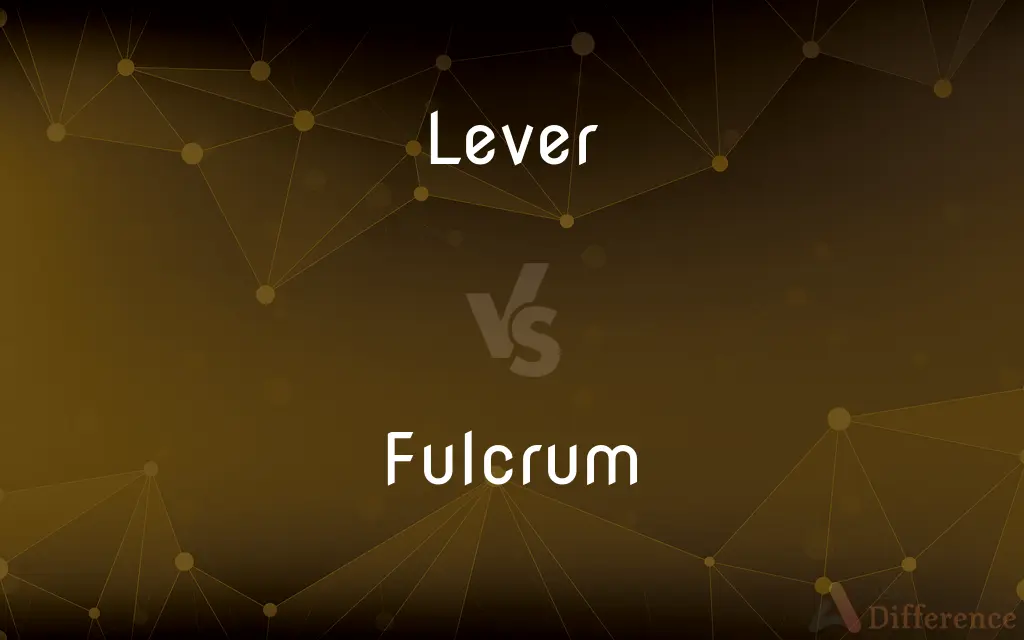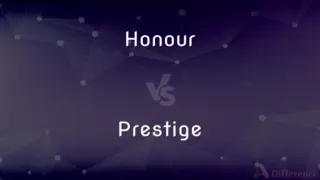Lever vs. Fulcrum — What's the Difference?
Edited by Tayyaba Rehman — By Maham Liaqat — Updated on April 20, 2024
Lever employs force to lift or move loads, utilizing a rigid bar that pivots on a fulcrum; the fulcrum itself is the support point that enables the lever's motion.

Difference Between Lever and Fulcrum
Table of Contents
ADVERTISEMENT
Key Differences
A lever is a simple machine comprising a rigid bar that moves objects by applying force at one point and overcoming resistance at another. Whereas the fulcrum, often a fixed point, supports the lever and is crucial for distributing the force applied.
The lever operates by magnifying an input force to lift heavier loads or overcome resistance, effectively increasing the mechanical advantage. On the other hand, the fulcrum's position relative to the input force and load greatly influences the efficiency of the lever, determining the amount of force required.
In practical applications, the length of the lever arm can vary to adjust the mechanical advantage, with longer arms requiring less force to move a load. In contrast, the fulcrum must be strategically placed to optimize this advantage, balancing the lever appropriately.
Levers are classified into three types based on the fulcrum's position relative to the effort and load: first class, second class, and third class. Whereas each type of lever uses the fulcrum differently to achieve varying mechanical advantages.
In everyday tools, levers appear as pliers, crowbars, and scissors, where manual force is amplified to perform tasks more efficiently. Meanwhile, fulcrums are integrated into these tools, often unseen but essential for their functionality.
ADVERTISEMENT
Comparison Chart
Definition
A rigid bar used to move or lift loads
The point on which a lever rests or is supported
Function
Transfers force to move or lift objects
Supports the lever and allows it to pivot
Position in mechanism
Extends from the fulcrum to the point of effort
Fixed location, usually at the center or end
Impact on force
Multiplies the applied force
Determines the pivot point and leverage
Types
First class, second class, third class
No types, but varies in position
Compare with Definitions
Lever
Simple machine.
A crowbar is a type of lever used to pry open objects.
Fulcrum
Balance point.
Carefully positioned fulcrum can change the effort needed to lift a load.
Lever
Tool component.
The handles of a pair of scissors act as levers.
Fulcrum
Support feature.
The hinge acts as the fulcrum for a door, allowing it to swing open and closed.
Lever
Bar that pivots.
A seesaw is a lever with the fulcrum at its midpoint.
Fulcrum
Pivot point.
The fulcrum of a seesaw is located where the board balances evenly.
Lever
Mechanical advantage device.
Levers in a pinball machine help propel the ball with speed.
Fulcrum
Central point.
The fulcrum in a lever system determines the efficiency of force application.
Lever
Force multiplier.
Using a lever, one can lift much heavier weights than normally possible.
Fulcrum
Structural component.
In a lever, the fulcrum's position is crucial for achieving the desired mechanical advantage.
Lever
A lever ( or US: ) is a simple machine consisting of a beam or rigid rod pivoted at a fixed hinge, or fulcrum. A lever is a rigid body capable of rotating on a point on itself.
Fulcrum
The point or support on which a lever pivots.
Lever
A rigid bar resting on a pivot, used to move a heavy or firmly fixed load with one end when pressure is applied to the other
A tyre lever
Fulcrum
(Zoology) An anatomical structure that acts as a hinge or a point of support.
Lever
Lift or move with a lever
She levered the lid off the pot with a screwdriver
Fulcrum
An agent through which vital powers are exercised.
Lever
A simple machine consisting of a rigid bar pivoted on a fixed point and used to transmit force, as in raising or moving a weight at one end by pushing down on the other.
Fulcrum
(mechanics) The support about which a lever pivots.
It is possible to flick food across the table using your fork as a lever and your finger as a fulcrum.
Lever
A projecting handle used to adjust or operate a mechanism.
Fulcrum
(figurative) A crux or pivot; a central point.
Lever
A means of accomplishing; a tool
Used friendship as a lever to obtain advancement.
Fulcrum
A prop or support.
Lever
To move or lift with a lever
Levered up the manhole cover.
Fulcrum
That by which a lever is sustained, or about which it turns in lifting or moving a body.
Lever
To move (oneself, for example) in a manner resembling the use of a lever
"[He] levered himself out the window all the way to his waist" (Stephen King).
Fulcrum
An accessory organ such as a tendril, stipule, spine, and the like.
Lever
To fund at least in part with borrowed money; leverage.
Fulcrum
The horny inferior surface of the lingua of certain insects.
Lever
(mechanics) A rigid piece which is capable of turning about one point, or axis (the fulcrum), and in which are two or more other points where forces are applied; — used for transmitting and modifying force and motion.
Fulcrum
The connective tissue supporting the framework of the retina of the eye.
Lever
Specifically, a bar of metal, wood or other rigid substance, used to exert a pressure, or sustain a weight, at one point of its length, by receiving a force or power at a second, and turning at a third on a fixed point called a fulcrum. It is usually named as the first of the six mechanical powers, and is of three kinds, according as either the fulcrum F, the weight W, or the power P, respectively, is situated between the other two, as in the figures.
Fulcrum
The pivot about which a lever turns
Lever
A small such piece to trigger or control a mechanical device (like a button).
Lever
(mechanics) A bar, as a capstan bar, applied to a rotatory piece to turn it.
Lever
(mechanics) An arm on a rock shaft, to give motion to the shaft or to obtain motion from it.
Lever
A crowbar.
Lever
(rare) A levee.
Lever
(transitive) To move with a lever.
With great effort and a big crowbar I managed to lever the beam off the floor.
Lever
To use, operate or move (something) like a lever (physically).
Lever
To use (something) like a lever (in an abstract sense).
Lever
To increase the share of debt in the capitalization of a business.
Lever
(obsolete) Rather.
Lever
More agreeable; more pleasing.
Lever
Rather.
For lever had I die than see his deadly face.
Lever
A rigid piece which is capable of turning about one point, or axis (the fulcrum), and in which are two or more other points where forces are applied; - used for transmitting and modifying force and motion. Specif., a bar of metal, wood, or other rigid substance, used to exert a pressure, or sustain a weight, at one point of its length, by receiving a force or power at a second, and turning at a third on a fixed point called a fulcrum. It is usually named as the first of the six mechanical powers, and is of three kinds, according as either the fulcrum F, the weight W, or the power P, respectively, is situated between the other two, as in the figures.
Lever
A bar, as a capstan bar, applied to a rotatory piece to turn it.
Lever
A rigid bar pivoted about a fulcrum
Lever
A simple machine that gives a mechanical advantage when given a fulcrum
Lever
A flat metal tumbler in a lever lock
Lever
To move or force, especially in an effort to get something open;
The burglar jimmied the lock
Raccoons managed to pry the lid off the garbage pail
Common Curiosities
Are there any levers that do not use a fulcrum?
No, all levers require a fulcrum to provide the pivot point that allows the lever to operate.
How does the length of the lever arm affect its performance?
A longer lever arm reduces the amount of force required to lift a load, increasing the mechanical advantage.
How do engineers decide where to place a fulcrum in a lever system?
Engineers place the fulcrum based on the desired mechanical advantage, balancing the force applied and the resistance to be overcome.
What are examples of levers in everyday life?
Examples include door handles, pliers, and bottle openers, where force is applied to perform tasks more efficiently.
Can the fulcrum of a lever be moved while in use?
Typically, the fulcrum is fixed during use to maintain stability and consistent mechanical advantage, though some tools allow adjustment for different uses.
Can the fulcrum be considered a part of the lever?
While intimately related, the fulcrum is technically separate from the lever itself; it serves as the support or pivot point for the lever.
How does changing the fulcrum position affect the force required?
Moving the fulcrum closer to the load decreases the force required to lift the load, whereas moving it away increases the force needed.
What role does the fulcrum play in determining the type of lever?
The fulcrum’s position relative to the load and the effort determines whether a lever is first, second, or third class.
What materials are typically used to construct levers and fulcrums?
Levers and fulcrums are often made from rigid materials like metal or wood, which can sustain significant force without bending.
What is the primary difference between a lever and a fulcrum in terms of physical structure?
The lever is a movable bar that applies force, while the fulcrum is a fixed point that supports the lever.
What scientific principles are involved in the operation of levers and fulcrums?
Levers and fulcrums operate based on principles of physics, specifically torque and equilibrium.
How do levers affect the direction of force applied?
Levers can change the direction of the applied force, making it easier to perform tasks such as lifting or moving objects vertically using horizontal force.
How do safety considerations affect the design of lever systems?
Safety considerations dictate ensuring that levers and fulcrums can handle the maximum expected forces without failure, to prevent accidents.
What is the impact of lever and fulcrum design on tool efficiency?
The design of the lever and the placement of the fulcrum directly impact the tool's efficiency by affecting the force multiplication and control.
Are fulcrums always located at the midpoint of levers?
No, fulcrums can be located at various points along the lever to create different types of levers, affecting the mechanical advantage and operational characteristics.
Share Your Discovery

Previous Comparison
Honour vs. Prestige
Next Comparison
Adolescence vs. AdolescentAuthor Spotlight
Written by
Maham LiaqatEdited by
Tayyaba RehmanTayyaba Rehman is a distinguished writer, currently serving as a primary contributor to askdifference.com. As a researcher in semantics and etymology, Tayyaba's passion for the complexity of languages and their distinctions has found a perfect home on the platform. Tayyaba delves into the intricacies of language, distinguishing between commonly confused words and phrases, thereby providing clarity for readers worldwide.














































